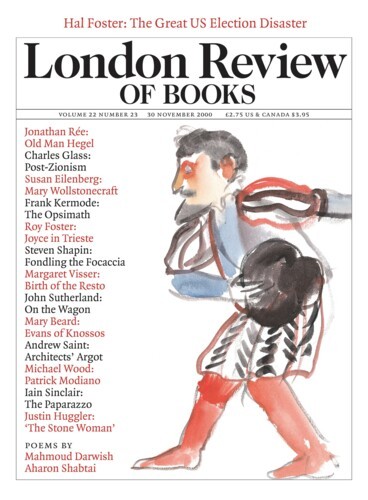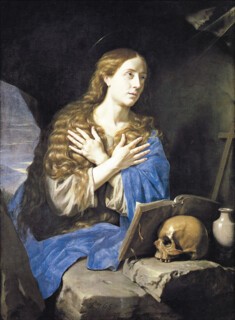In assembling Le Dieu caché: les peintres du Grand Siècle et la vision de Dieu, a collection of 63 French 17th-century religious pictures which can be seen at the Villa Medici in Rome until 28 January, Olivier Bonfait and Neil MacGregor challenge us to take theology as seriously as aesthetics. They also prove that it requires more than a sensitive eye and a generous imagination to understand a picture. The thesis of the exhibition and its catalogue (Edizioni de Luca, 283 pp., 60,000 lire, 18 October, 88 8016 388 4) is that the paintings gathered here express an identifiably French spirituality. The ‘God’ of the exhibition title is Christ, hidden in the prophecies and prefigured in the stories of the Old Testament, hidden again in his incarnation, and held to be present in the Eucharist. He is the object of a form of worship in which rational thinking supports an intense spirituality.
Some of these pictures – above all those of Philippe de Champaigne – seem to be direct illustrations of Pascal’s paradox of faith and reason: ‘If we submit everything to reason, our religion will have no mysterious and supernatural element. If we offend the principles of reason, our religion will be absurd and ridiculous.’ The most beautiful are in no sense Protestant, but Le Nain (attributing a given picture to any one of the brothers, Antoine, Louis or Mathieu, is often impossible), Poussin, Philippe de Champaigne and Georges de la Tour all appeal to a Protestant sensibility by suggesting that the struggles and triumphs of faith take place in the mind and that art must treat them obliquely. As such, their work is quite unlike the paintings of the Baroque Counter-Reformation – also represented here – which illustrate the grandeur of sacrifice and the transforming ecstasy of revelation more directly.
In Philippe de Champaigne, subjects are chosen in which the image can be still and hieratic. Decorum is at the heart of this approach. Champaigne was born in Brussels but was not a Fleming in spirit. His Angel of the Annunciation stands, rather than kneels or flies. No one is seen in a pose they could not hold. The drawing is firm and correct, the play of light is worked out as much as observed, but with such authority that his painting – like Perrault’s architecture – demands admiration even when it is emotionally chilly.
Painters who subvert the intentions of patrons – as Caravaggio did with his low-life models and sprawled saints, and Goya with royal portraits which read as caricatures – flatter a modern idea of the independence and revolutionary duties of art. Although the gears of our artistic culture mesh as tightly as any ever did with sources of power and money we can point to acts of aesthetic intransigence which, we feel, provide a firewall between art and established institutions. Champaigne, by contrast, claims his place in the structures of state and church and acknowledges their authority.
Perhaps as a result, the paint is anonymous – the character of a mark does not attract attention to itself except when a change of surface texture – say, between one fabric and another – must be registered. (David would let this French tradition of brushwork be the vehicle for political rather than religious probity.) This is a very different craft from the more energetic kind which makes surfaces in Rubens’s paintings seem more alive than the hair or fur or flesh they describe. I can, for example, think of no painter who gives a fairer account than Champaigne of the foot – a part of the body which is often underanalysed, even when the structure of face and hands has been thought through.
Pascal’s comment on the vanity of an art which is admired for achieving likenesses of things that are not admired in themselves is quoted more than once in the catalogue, and the Jansenist severity of Port-Royal would make the sect’s two convents seem an unlikely place for paintings to be gathered. Yet there are thirty canvases which can be identified as coming from Port-Royal. The two which Philippe de Champaigne gave when his daughter became a Jansenist nun – a Mary Magdalene and a John the Baptist – are in the exhibition. Neil MacGregor’s catalogue notes shed light on the choice of saints and make sense of their decorous presentation and of the place art could have among the spiritually frugal. St John, bright-eyed, with strong, well-muscled arms, his hair neatly parted and his camel-hair shirt firmly belted, is nothing like the starved Baptist of Donatello, still less like Caravaggio’s petulant boys. He is neither hungry nor ragged. Mary Magdalene is similarly proper: her long unbound hair conceals the rough fabric of a loose chemise – no suggestion here of flesh beneath. Tears run down her cheek but her expression is serious not ecstatic.
These were saints who, MacGregor explains, a young woman of good family could take as models. The theologian Pierre de Bérulle, consoling Henrietta Maria, then on her way to wed Charles I in the desert of Protestant England, offered Mary Magdalene as an example, maintaining that she came from a good family (as did St John before he abandoned society) and was of irreproachable character – not a prostitute at all. Both had given up the comforts that go with rank and wealth to serve Jesus in poverty – which is also what the daughter of the painter was doing in her convent. The pictures show not so much imagined historical figures as imagined respectable contemporaries who have assumed the attributes of saints. The devotional picture, then, is not an icon which helps you think about the saint, so much as an image which helps you imagine yourself being saintly.
There are other pictures which make better sense in this exhibition than they would in a context which did not encourage you to ask what they say about religion in society. Le Nain’s picture from the Louvre which has long been known as Repas de paysans is among the paintings grouped under the title ‘L’Eucharistie: le signe de la présence divine’. MacGregor interprets it as showing an act of religious charity, not the dignity of poverty. The clothes of the three people closest to us are torn or ragged; the man and the boy on the right are barefoot. But the central figure, though plainly dressed, isn’t ragged; nor is the woman on his left or the children behind him. There are two levels of society here. The man sits, or perhaps kneels, behind a makeshift table – the top is on a level with the seats of the stools on which the two poor men sit. Bread and wine stand on a white cloth. The iconography echoes representations of the supper at Emmaus.
Some have seen the painting’s sobriety as evidence of Le Nain’s Protestant sympathies. The recognition that what is shown is an act of charity has led to another title: Le Fermier bienfaisant. MacGregor is more precise. He suggests that it shows one of those households in which the taking in and feeding of the poor was a customary act of Christian charity – a virtue which, incidentally, strengthened the bonds of secular society.
The painting of Philippe de Champaigne and Le Nain is a vehicle for seriousness, but not for tragedy. Georges de La Tour’s plain, plump girls playing the part of angels or Mary Magdalenes are transformed into the very type of meditating piety by the glamour of a candle flame, the light from which, more than the human flesh it selectively exposes, is the subject of the picture. A Vanitas in which a flower, a skull and an hour-glass tell us that our time will soon be up scarcely needs much explanation.
To open up the range of feeling is more risky. Poussin avoids sentimentality by reaching back. In the Dublin Lamentation emotion is read from familiar gestures, dignified by familiar arrangements of drapery and dispositions of figures. Other pictures in the same section of the exhibition – ‘Lamentations sur le Christ mort’ – stumble. Philippe de Champaigne’s altarpiece, Le Voeu de Louis XIII, which puts King, Christ, Mary and attendant putti in the same frame is too much like window-dressing; the moment for saint and donor pictures was past. Lesser works fail because they seem sentimental, improbable or frivolous. Some things, despite my best efforts, I find objectionable. Perhaps those, like me, for whom Port-Royal is an easy way into French spirituality are bound to rebel at Lubin Baugin’s languid Christ mort veillé par deux anges, which brings the erotic softness of Correggio to a body which Poussin has, a few yards away, taught us to see harshly.
Some of the pictures in this exhibition were hung in private houses as aesthetic rather than devotional objects. Others (including this one of Baugin’s, the catalogue suggests) were to be found in private chapels. Unless you have some grasp of what it would be like to find religious comfort, religious bliss even, in front of a picture, you must register your dislikes with some humility. Le Dieu caché teaches what it is easy to understand in Rome, but more difficult to be sure of in Britain: that pictures in churches and chapels work differently from pictures in galleries and drawing-rooms.
Send Letters To:
The Editor
London Review of Books,
28 Little Russell Street
London, WC1A 2HN
letters@lrb.co.uk
Please include name, address, and a telephone number.


